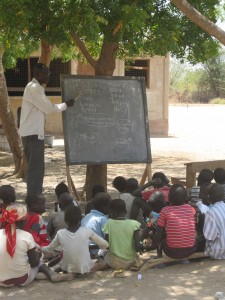By Mary Mendenhall
Director, IRC-University of Nairobi Education in Emergencies Partnership
In 2009, the International Rescue Committee (IRC) and the University of Nairobi joined forces to establish the first-ever graduate program for Education in Emergencies. This partnership between a humanitarian NGO and an African university seeks to build a cadre of qualified education practitioners and scholars prepared to respond to the educational needs of children and youth whose lives have been affected by conflict and crisis.
Photo of faculty after completing capacity building series, supported by IRC and TC.
Children and youth living in Sub-Saharan Africa figure greatly in out-of-school statistics and their educational access and attainment are further hampered by armed conflict and natural disasters. According to the UNESCO Institute of Statistics, half of the 61 million primary school-aged children currently out of school globally live in Sub-Saharan Africa, with another 10 million in the region dropping out every year. Almost three-quarters of out-of-school girls are expected never to enroll, compared to two-thirds of boys. Out of the thirty-five countries that were affected by armed conflict from 1999 to 2008, fifteen are in Sub-Saharan Africa, where protracted armed conflicts remain all too common. As a result, young people affected by conflict in Sub-Saharan Africa face enormous barriers to accessing quality education and subsequently earning a livelihood and contributing positively to their communities.
The decision to launch this flagship program at the University of Nairobi and to focus on East Africa was based on a number of factors. First and foremost, Kenya had just experienced its own post-election violence in 2007-08 after the last presidential election. The crisis highlighted the need for educators and school administrators to be better equipped to prevent, prepare for and respond to inter-ethnic conflicts through schools and educational processes. The faculty and administrators within the School of Education at the University of Nairobi were keen to play a role in this process and sought out an opportunity to partner with the IRC on this initiative.
Second, Kenya is host to an incredibly large number of refugees—the majority originating from Somalia and Sudan—in two refugee camps, both of which have been operating for over 20 years. Dadaab refugee camp, which is located in northeastern Kenya on the border with Somalia, is the largest camp in the world. It currently hosts close to 500,000 refugees, making it the third largest city in Kenya. Kakuma refugee camp on the border with South Sudan has been experiencing a renewed influx of arrivals from South Sudan as a result of continued violence and instability in the region, with the camp population exceeding 100,000 refugees. The availability and quality of education in both camps have been weak, but with second and third generations of children being born in the camp, educational opportunities must be increased and improved.
Class being held in Dadaab refugee camp during a study visit by UoN faculty; student initiative to develop appropriate early childhood materials for semi-nomadic communities.
Third, there are significant numbers of refugees residing outside of the camps in Nairobi and other cities and towns. According to UNHCR’s 2012 assessment of refugee education in Nairobi, there are over 55,000 refugees residing in the city, including more than 29,000 school-aged children, with numbers expected to rise in the future. Despite their relative ease of mobility in comparison to camp-based refugees, urban refugees experience discrimination, xenophobia and extortion in their efforts to attend school and receive an education.
Within this context and the challenges that accompany it, education practitioners require specialized knowledge, skills and qualifications to assist governments, international organizations, and local communities not only to prevent and better prepare for humanitarian crises but also to overcome the challenges of providing quality education during emergencies and in their aftermath. The need for qualified national education practitioners is particularly acute in Africa. Even though many educators have lived through emergencies and have tremendous practical experience, there are few opportunities, apart from on-the-job training and one-time workshops, for them to obtain the skills and qualifications required to be effective practitioners in the humanitarian field. To date, there are also few universities in Africa that have included humanitarian subjects in their curricula.[1]
The establishment of a University graduate program for Education in Emergencies responds to the need for comprehensive study and training opportunities that adequately equip graduates with the requisite skills they need to work with a diverse array of stakeholders in their collective efforts to provide quality education for children and youth affected by crisis. Graduate study, when coupled with experiential learning opportunities, provides a more meaningful and lasting way to build the capacity of current and emerging education practitioners in the East Africa and beyond.
Mary Mendenhall is a Lecturer in the Department of International and Transcultural Studies at Teachers College, Columbia University (starting Fall 2013).
Further Reading: IRC-University of Nairobi Education in Emergencies Partnership and Student Activities
Project/Partnership Overview: http://www.rescue.org/news/education-emergencies-10594
From child soldier to teacher: Ador’s story: http://www.rescue.org/blog/child-soldier-teacher-adors-story
The Kenya Forgiveness Project is an inspirational exhibit showcasing stories of forgiveness and reconciliation in Kenya in the aftermath of the violence that took place after the contested presidential elections in December 2007. The project was born out of a deep desire to contribute towards peace in the build up to the 2013 presidential election, which took place last week. One of the education in emergencies students who interned with the Forgiveness Project and was later hired has been working on this project, collecting stories, putting together exhibits, and touring the country. http://www.kenyaforgivenessproject.org/
Additional Resources
Borderless Higher Education for Refugees: http://crs.yorku.ca/bher
Council for Assisting Refugee Academics: http://academic-refugees.org/
IIE Scholar Rescue Fund: http://www.scholarrescuefund.org/pages/intro.php
Scholars at Risk: http://scholarsatrisk.nyu.edu/
Dadaab Stories: http://www.dadaabstories.org/
[1] Namusobya, S. (2008). Can’t Africans be Humanitarians too? Building Local Capacity to Co-ordinate and Manage Humanitarian Responses in Africa. Presentation to 3rd ICVA Conference; ‘Essential Humanitarian Reforms’, Geneva, Friday 1 February 2008.
Photo credit: Mary Mendenhall



